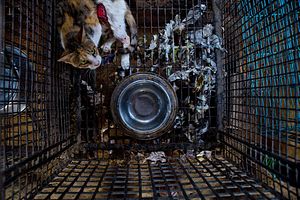It was a hot sultry day in the midst of an unforgiving summer when I visited two shelter homes for old, ailing, and injured animals in the north Indian city of Faridabad near Delhi. They are run by activist Ravi Dubey, whose day starts with feeding about 70 animals, routine treatments of the injured and ailing ones, and even attending emergency calls about animals involved in accidents.
As I entered the biggish enclosure of Aastha (meaning “faith”) Shelter Home, I was welcomed by a sweet dog, which came running, wagging his tail and did not leave my side till I had finished taking photos. The shelter was lined on three sides by several cages, which mainly housed dogs and cats. Most of them had collars around their necks, which meant they were under treatment for some injury or disease.
It was a humble setup; the floor was not cemented, but covered with dust and the occasional wailing of sick dogs and the constant buzz of flies broke the silence. The enclosure was dark except for a stream of light that entered through the sunroof.
As I kept shooting, Ravi quietly hung around, patiently answering my questions and instructing his staff, with a calm demeanor. Looking at him it would be impossible to gauge the kind of pressures that he handles in a day. He considers himself lucky if he gets the support and empathy of the layman, as there is little awareness about animal welfare in India, even in big cities.
I got a taste of this when suddenly a group of angry neighbors stormed into the shelter looking for a stray dog named Kalu (Black). These people had brought Kalu to the shelter after a minor injury, but he also had parvovirus and passed away days later. The residents were inconsolable, and angry; I could not help feeling miserable as I watched them bad mouth the staff. This is a thankless job that requires endless patience and determination to get through a day, on a daily basis.
After shooting at Aastha, I visited the neighboring shelter called Gau Sewa Chikitsa Sansthan (Institute of Medicine for Cow Service), inhabited by old, abandoned and injured cows. Dubey grows crops in nearby fields to feed the cows.
It was almost mid-day and my next tour was of the adjoining roads and open fields to see some of the around 250 cemented tubs installed by Ravi about three years ago for the street animals across the city. Called the Project Summer Lifeline, the first-of-its-kind in India. Trenches have also been dug up in the Aravalli hills areas and a water tanker goes around the whole city filling up these tubs, twice a day.
The People For Animals Trust, an umbrella body covering all the initiatives by Ravi, also educates local residents and shop owners in the adjoining areas about the usage of the tubs. It was heartening to see footprints of wild boars and buffaloes near the water embankments; I was told that many wild animals visit these water holes at night. When the temperatures rise up to 48 degrees Celsius in the peak of summers, when merely stepping out of your house could cause a heat stroke, one can only imagine how beneficial these tubs are for the street animals.
Through Project Roti, Ravi feeds hundreds of rotis, or Indian bread, to monkeys and cows daily. I was lucky to shoot this entire process on a rain-washed day. As my car approached the Gurgaon Aravalli road, hundreds of monkeys and langurs appeared from the adjoining wooded area, as if on cue. Of course they wait for this daily ritual, as I learnt later.
Ravi’s dream project is to buy land to build a hospital-cum-shelter. The existing shelters are rented, which doesn’t allow for expansion to accommodate the ever-growing number of animals that need care.
Here are some pictures from my shoots.
Sharmistha Dutta writes for StoriesAsia.
















































